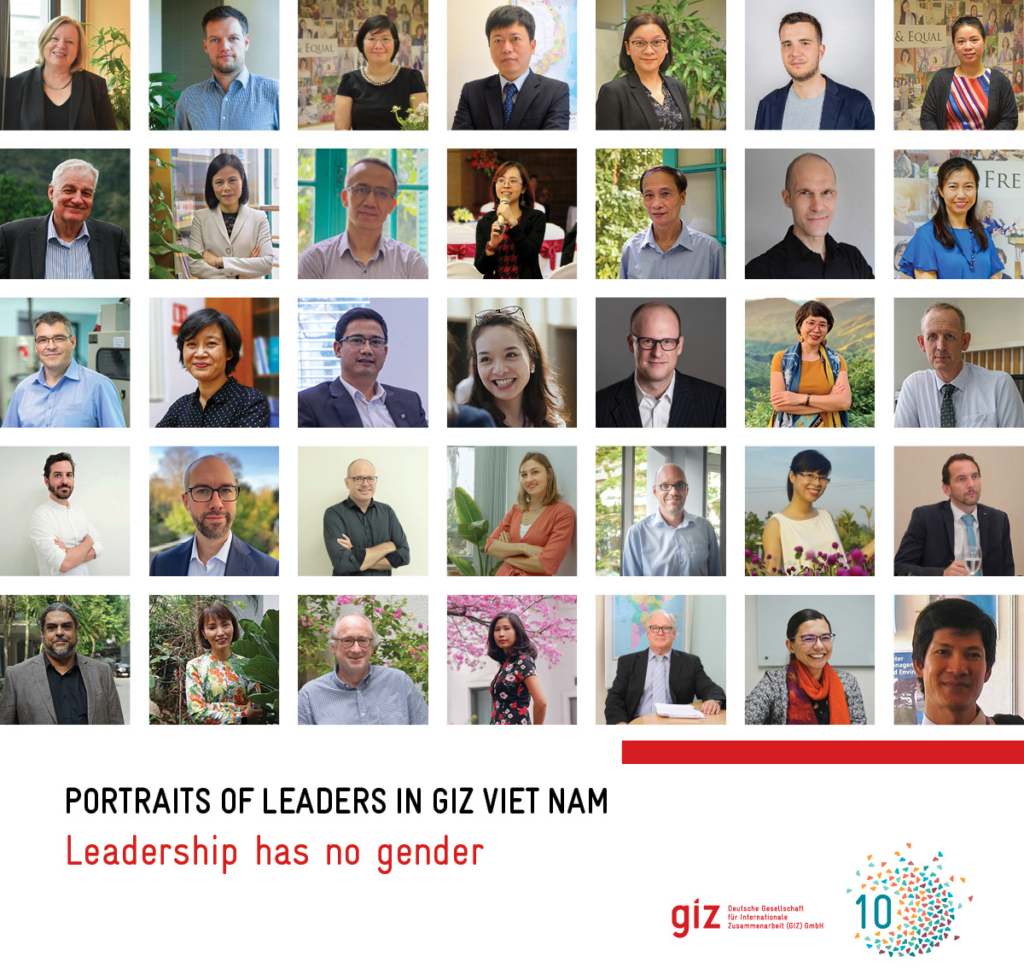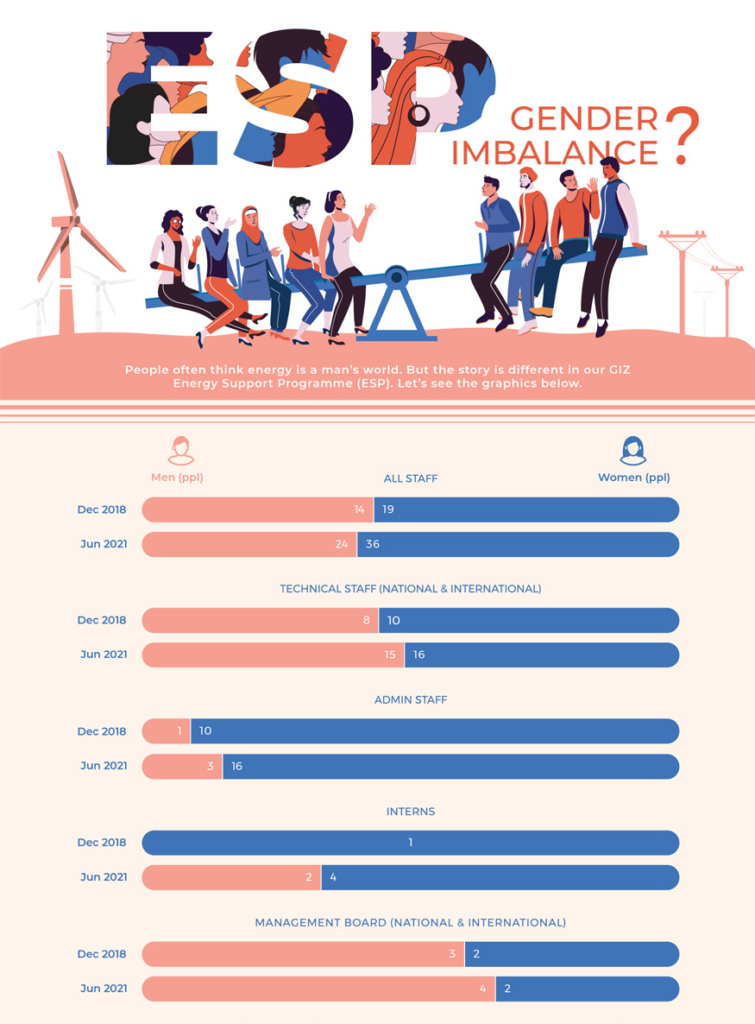
Contribution by GIZ Viet Nam’s Gender Circle
1. Corporate culture (50% of marks)
Gender equality is a key value and part of how we see ourselves. Describe your contribution, i.e. the measures, processes and/or approaches you use to make gender equality visible as part of our corporate culture and to champion it both internally and externally as a goal in itself and as a principle to guide action.
“What makes a true leader? Does gender matter?”. These questions are often raised in every discussion whenever we talk about leadership. In order to find the answers, it would be better to hear the voice of the insiders. In early 2021, GIZ Viet Nam’s Gender Circle initiated an idea of developing a photobook which features an overall picture of leaders in GIZ Viet Nam. It aimed to challenge a popular belief that men are better leaders because masculine characteristics are believed to be similar to the characteristics of a good leader.

Some highlights of the process of developing the photobook:
- “Leadership has no gender”, a key message of the photobook:
The most interesting thing highlighted from our interviews were that the leaders, regardless of their gender, shared the similar opinions on effective leadership and lessons learnt from their personal leadership journey. “Teamwork”, “common goal”, “shared vision” “diversity”, “equality”, “transparency”, “accountability”, “delegation” and “trust” were common words that were repeated frequently in our conversations with leaders. Results of interviews confirm that there is no difference in leadership qualities, attributes, and characteristics between female and male leaders. In other words, leadership has no gender.
- Linking with KUF principle:
Unintentionally, the sharing of leaders fitted so well with GIZ’s Cooperation and Leadership (KUF) principles even though interview questions were not directly related to those principles. Therefore, the 2nd photobook “Leaders in GIZ Viet Nam – Leadership has no gender” was formatted in the form of KUF principles. Each leader did not focus on only one principle, but Gender Circle randomly selected one of many interesting quotes taken from the interviews.
- Inspiring leadership:
Gender Circle members were so excited to talk with male leaders who embraced a view of gender equality and diversity, and actively translated it into practice in the adaptive and experimental ways. As interviewers, we were really inspired by strength and perseverance of female leaders in the organization, who leaned into living and working with authenticity and courage. We believe that when leaders promote the values of gender equality and human rights, they will not only expand their abilities to lead with greater strength but also forge a path for others to do the same. Hopefully, this book inspires leaders to take more commitments in promoting an inclusive and diverse workplace.
2. Gender competence (30% of marks)
Describe the context, your organisational unit and the challenges faced by your organisational unit or country and explain how you contributed to enhancing gender competence among your colleagues or in your organisational unit, a specific team or the company. Share the approaches that have proven successful.
Vietnamese culture is rooted in interpretations of Confucianism which supports gender inequality by characterizing male privilege and hierarchical relationship. Gender stereotypes are seen as the most pervasive barrier for women to participate equally in the social, economic, and political life. For instance, men are perceived as better leaders because masculine characteristics are believed to be similar to the characteristics of a good leader. Meanwhile, women are stereotyped to have low leadership capacity. It is commonly perceived that women make decisions based on their feelings (48.4%), are incapable of working under pressure (64.49%) and not suitable for leadership positions (48.23%) . For women who are in leadership positions, there are disproportionally high expectations and a double standard in how their leadership is evaluated. Together with the criteria of good technical capacity, morality, political loyalty, and management skills, women leaders are expected to be beautiful, well-dressed, articulate, modest and to be a good wife and good mother. Furthermore, women leaders are also expected to accomplish their housework first before participating or/and taking leadership roles in the society. These stereotypes exist among women and men, all age groups, and seem to be most prevalent within groups who are considered progressive.
If an organization aims to create an enabling environment where full talent pool of emerging leaders can maximise their potentials and current leaders are judged objectively, it is necessary to change the above-mentioned perceptions. In 2020 & 2021, GIZ Viet Nam’s Gender Circle has been taking some approaches which do not directly talk about women’s leadership in particular, but also help people to have better understanding of gender equality and women’s rights in general. These include:
- Using the above-mentioned photobook as evidence to show that there is no difference in leadership qualities, and characteristics between female and male leaders. And both women and men can be good leaders.
- Organising a brown bag lunch to discuss with the new Country Director on gender equality and women’s rights. It combined a quiz game about facts & figures on situation of gender equality in Vietnam and a sharing section on the Country Director’s personal experience, lessons learnt and opinions on gender equality and women’s leadership. She is a good example to prove that women can be in the top management positions.
- Creating a factsheet on gender distribution in the GIZ Viet Nam’s Energy Support Programme team in 02 points of time: December 2018 and June 2021. As energy sector is often dominated by men so project gender focal points of the cluster initiated to make a fact sheet assessing how gender was distributed in their own team. The finding showed a more gender balanced picture of energy staff over the years. Nevertheless, admin team was still dominated by women while management team was over-represented by men. This factsheet was circulated to team members and leaders with a key message to advocate for more diversity in the gender imbalanced teams.
- Raising awareness for staff on gender diversity and LGBTI movement in Vietnam during GIZ’s Diversity Week 2021. Due to COVID-19 situation, this activity was conducted virtually and moderated by 02 guest speakers who were from a local NGO, working on LGBTI rights. Through a quiz game and an experience sharing, GIZ staff had more knowledge and understanding on key concepts of gender identity, sexual orientation, gender expression, sexual characteristics, and a better insight of LGBTI movement in Viet Nam. Even this activity did not directly mention about women’s leadership, it helped people to understand the importance of an inclusive and diverse workplace where each individual, as a woman, or LBGTI people have opportunities to develop their potentials, including leadership skills.
- Conducting different activities (e.g. development and dissemination of communication materials, brown bag lunches at country/project offices etc.) to raise awareness for staff on sexual exploitation, abuse and harassment (SEAH) and call for their commitment and actions on zero tolerance to this issue in the workplace. Once a safe working space for all is created, leaders themselves, regardless of gender, gender identity and sexual orientation, can maximise their potentials in a comfortable and secure manner.
3. Cooperation (20% of marks)
Gender equality cannot be achieved by individuals alone. It is a joint task – how did you go about it? Who did you cooperate with? What were the major challenges you encountered individually or together? What were the three key success factors? What were the outcomes?
The photobook on leaders in GIZ Vietnam is an insourcing product which was jointly developed by Gender Circle members and PR/communication officers, with the fruitful cooperation of leaders. In particular, PR/communication officers supported to do filming and recording of interview as well as designing of the book. This book could not be completed without the agreement and cooperation of leaders to participate in the interview and to give consent for using their quotes and pictures
A major challenge to develop the photobook was the complicated situation of COVID-19 so most of communication activities related to process of developing the photobook was done virtually.
Three key success factors:
- Digital tool is powerful:
In order to deal with social distancing situation of COVID-19, most of interviews with leaders in round 2 were conducted via Ms Team. It was also impossible to take the picture of leaders during the interviews, so we had to get the support from PR/com officers and leaders to select their available profile pictures for designing the book.
- Two targets with one arrow:
As mentioned above, unintentionally, the sharing of leaders fitted so well with GIZ’s Cooperation and Leadership (KUF) principles even though interview questions were not directly related to those principles. Therefore, Gender Circle decided to format the 2nd book in the form of KUF principles. As a result, this book hit two targets with one arrow, including (i) disseminating the key message “Leadership has no gender”; and (ii) introducing KUF principles with concrete examples of leaders’ experience & opinion sharing.
- Photobook, a simple way to deliver the message:
Instead of sharing the whole stories of all leaders with a lengthy book, Gender Circle selected to develop the photobook with quotes and profile pictures of leaders because it can make audience easily capture and remember the messages.
As a result, this book was highly appreciated by leaders and other colleagues. For example, GIZ’s Gender Commissioner promoted it on the LinkedIn page. It was also shared within GIZ’s KUF ambassador network. It is planned to convert this book into a mini exhibition at the upcoming gender event.

 GIZ Gender Website
GIZ Gender Website

